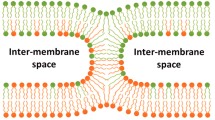Abstract.
We propose that the first stage of membrane fusion need not be the formation of a single stalk. Instead, we consider a scenario for defect-induced membrane fusion that proceeds cooperatively via multiple stalk formation. The defects (stalks or pores) attract each other via membrane-mediated capillary interactions that result in a condensation transition of the defects. The resulting dense phase of stalks corresponds to the so-called fusion intermediate.
Similar content being viewed by others
References
B.R. Lentz, V. Malinin, M.E. Haque, K. Evans, Curr. Opin. Struct. Biol. 10, 607 (2000).
B.R. Lentz, D.P. Siegel, V. Malinin, Biophys. J. 82, 557 (2002).
L.K. Tamm, J. Crane, V. Kiessling, Curr. Opin. Struct. Biol. 13, 453 (2003).
D. Gindell, L. Ginsberg, Problems in physical interpretation of membrane interaction and fusion, in Membrane Fusion, edited by G. Paste, G.L. Nicolson (Elsevier/North-Holland Biomedical Press, 1978) pp. 791-833.
S.W. Hui, T.P. Stewart, L.T. Boni, Science 212, 921 (1981).
M.M. Kozlov, V.S. Markin, Biofizika 28, 242 (1983).
D.P. Siegel, Biophys. J. 65, 2124 (1993).
D.P. Siegel, Biophys. J. 76, 291 (1999).
V.S. Markin, J.P. Albanesi, Biophys. J. 82, 693 (2002).
Y. Kozlovsky, M.M. Kozlov, Biophys. J. 82, 882 (2002).
Y. Kozlovsky, L.V. Chernomordik, M.M. Kozlov, Biophys. J. 83, 2634 (2002).
P.L. Kuzmin, J. Zimmerberg, Y.A. Chizmadzhev, F.S. Cohen, Proc. Natl. Acad. Sci. U.S.A. 98, 7235 (2001).
Note that within the framework of the recent model of the stalk [10], the hemifusion is equivalent to the trans-monolayer contact (TMC).
L. Yang, H.W. Huang, Science 297, 1877 (2002).
L. Yang, H.W. Huang, Biophys. J. 84, 1808 (2003); L. Yang, L. Ding, H.W. Huang, Biochemistry 42, 6631 (2003).
D.C. Turner, S.M. Gruner, Biochemistry 31, 1340 (1992).
M. Rappolt, A. Hickel, F. Bringezu, K. Lohner, Biophys. J. 84, 3111 (2003).
S.A. Safran, Statistical Thermodynamics of Surfaces, Interfaces, and Membranes (Addison-Wesley, Reading, MA, 1994).
B.P. Jena, S.-J. Cho, A. Jeremic, M.H. Stromer, R. Abu-Hamdah, Biophys. J. 84, 1337 (2003).
M.M. Kozlov, L.V. Chernomordik, Biophys. J. 75, 1384 (1998).
G.I. Bell, M. Dembo, P. Bongrand, Biophys. J. 45, 1051 (1984).
R. Bruinsma, M. Goulian, P. Pincus, Biophys. J. 67, 746 (1994).
R. Bruinsma, A. Behrisch, E. Sackmann, Phys. Rev. E 61, 4253 (2000).
D.M. Zuckerman, R. Bruinsma, Phys. Rev. Lett. 74, 3900 (1995); Phys. Rev. E 57, 964 (1998).
R. Lipowsky, Phys. Rev. Lett. 77, 1652 (1996).
T.R. Weikl, R. Lipowsky, Phys. Rev. E 64, 011903 (2001).
T.R. Weikl, D. Andelman, S. Komura, R. Lipowsky, Eur. Phys. J. E 8, 59 (2002).
J. Nardi, R. Bruinsma, E. Sackmann, Phys. Rev. E 58, 6340 (1998); J. Nardi, T. Feder, R. Bruinsma, E. Sackmann, Europhys. Lett. 37, 371 (1997).
R. Bruinsma, E. Sackmann, C. R. Acad. Sci. Paris 2, 803 (2001).
P.-G. de Gennes, P.-H. Puech, F. Brochard-Wyart, Langmuir 19, 7112 (2003).
S.Y. Qi, J.T. Groves, A.K. Chakraborty, Proc. Natl. Acad. Sci. U.S.A. 98, 6548 (2001).
S. Raychaudhuri, A.K. Chakraborty, M. Kardar, Phys. Rev. Lett. 91, 208101 (2003).
H.-Y. Chen, Phys. Rev. E 67, 031919 (2003).
C.W. Maier, A. Behrisch, A. Kloboucek, D.A. Simson, R. Merkel, Eur. Phys. J. E 6, 273 (2001).
J. Israelachvili, Intermolecular and Surface Forces: With Applications to Colloidal and Biological Systems (Elsevier, Amsterdam, 1991).
W. Helfrich, Z. Naturforsch. 28c, 693 (1973).
R. Bar-Ziv, R. Menes, E. Moses, S.A. Safran, Phys. Rev. Lett. 75, 3356 (1995).
R. Menes, S.A. Safran, D. Kessler, Europhys. Lett. 40, 225 (1997).
R. Menes, S.A. Safran, Phys. Rev. E 56, 1891 (1997).
This is similar to the case of membrane-induced interactions between inclusions (for a single bilayer membrane): N. Dan, P. Pincus, S.A. Safran, Langmuir 9, 2768 (1993); N. Dan, A. Berman, P. Pincus, S.A. Safran, J. Phys. II, 4, 1713 (1994).
Note, that we obtain the expression for the interaction free energy between two junctions which is different by a numerical factor from the corresponding one reported in reference [22].
G. Lei, R.C. MacDonald, Biophys. J. 85, 1585 (2003).
M. Muller, K. Katsov, M. Schick, Biophys. J. 85, 1611 (2003); J. Chem. Phys. 116, 2342 (2002).
M.J. Stevens, J.H. Hoh, T.B. Wolf, Phys. Rev. Lett. 91, 188102 (2003).
Author information
Authors and Affiliations
Corresponding author
Additional information
PACS:
87.16.Dg Membranes, bilayers, and vesicles - 68.05.-n Liquid-liquid interfaces - 64.60.-i General studies of phase transitions
Rights and permissions
About this article
Cite this article
Lukatsky, D.B., Frenkel, D. Multiple stalk formation as a pathway of defect-induced membrane fusion. Eur. Phys. J. E 14, 3–6 (2004). https://doi.org/10.1140/epje/i2004-10005-5
Received:
Issue Date:
DOI: https://doi.org/10.1140/epje/i2004-10005-5




